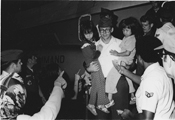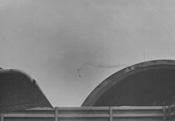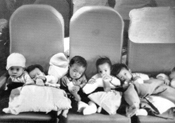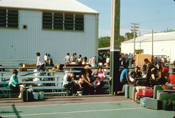April 30, 1975: The Fall of Saigon - Evacuation


In the beginning, the operation focused on the evacuation of orphans from Saigon. Air Force military and dependant volunteers help unload C-141 Starlifter upon landing at Clark Air Base.
(Jim Stantiz Collection [VA050177])

AC 119k being shot down by SA7 above TSN runway on the 29th April 1975 at 0700 hrs, 1st sequence
(William E. LeGro Collection [VA039222])
As the military situation rapidly deteriorated in South Vietnam, the Americans still remaining in country began to plan for an evacuation that would get all of the Americans and their dependents safely out of the country. They could not simply pick up and leave because it would trigger a mass panic in Saigon much like the debacle that occurred in Da Nang. More importantly, many Americans felt that they had a responsibility to evacuate the Vietnamese people who had worked for the U.S. government and military. The Americans knew that if they left these loyal people behind they faced imprisonment, hardship, and even death at the hands of the North Vietnamese.
The DAO and the American embassy began reviewing the evacuation plan as early as December 1974. The plan, originally called Talon Vise and later renamed Frequent Wind featured a stepped approach for evacuation:
- Level One – evacuation by commercial airlift from Tan Son Nhut and other airfields near Saigon
- Level Two – evacuation by military airlift
- Level Three – evacuation by boat from Saigon ports
- Level Four – evacuation by helicopter to U.S. Navy ships waiting offshore
As cities in I and II Corps fell, U.S. government officials ordered Americans out of the country in an effort to reduce numbers and expedite the final evacuation. On April 1, the DAO located at Tan Son Nhut airport began operating the Evacuation Control Center twenty-four hours a day. They processed all of the paperwork and visas for the refugees and coordinated all of the evacuation flights and activities. The rest of the DAO compound was converted into a refugee center capable of holding 1,500 people as they waited to leave the country. In the beginning the paperwork was a nightmare. The South Vietnamese government was adamant that no draft-age male leave the country, and any South Vietnamese citizen wanting to leave had to have all of the proper visas signed in advance or they would not be allowed into the Evacuation Control Center. The Americans also had their own problems as many Americans with Vietnamese spouses refused to leave the country without their spouse's often large extended family. Families were forced to make some very difficult decisions and many of the early flights leaving Saigon did so with empty seats.
- The Honorable Moncrieff J. Spear [concerning the evacuation of the Summer Institute of Linguistics] (1 page) [No Date] [10840101013] - full record
- Report on Phu Bon Province and Convoy [evacuation of Phu Bon] (4 pages) [24 March 1975] [10840101005] - full record
- Communist Gunners Halt Evacuation of Refugees from Da Nang (2 pages) [31 March 1975] [2132512040] - full record
- Recollection of Evacuation Events [evacuation of Nha Trang] (2 pages) [10 April 1975] [10840101007] - full record
By April 3, the Americans began planning for the end. They made maps of the city marking areas with high concentrations of Americans and at-risk Vietnamese as well as rooftops that could be used for helicopter evacuation. Busses and radios were secured and routes planned for picking everyone up to deliver them to Tan Son Nhut, the embassy, or a designated rooftop. Assembled teams took charge of certain rooftops or bus routes to ensure everything would run smoothly.
An unexpected C-5A airplane arrived at Tan Son Nhut on April 4. The DAO decided to take advantage of the plane to evacuate 250 orphans and fifty of their employees, dubbing the flight "Operation Babylift." Shortly after takeoff the plane's rear doors flew off, forcing it to turn around and eventually crash in a rice paddy near Tan Son Nhut. In order to maximize space, many of the passengers did not have seats and some shared seat belts. Many on the flight were injured or killed; only 175 survived. After the crash new orders were handed down – no passengers on planes unless they have a seat with a seat belt – restricting the capacity of the large C-141s to ninety-four passengers and the C-130s to only seventy-five.
On April 20, the U.S. and South Vietnamese governments worked out an expedited visa process. Any American citizen could sponsor a Vietnamese dependent and their immediate family out of the country by signing an affidavit promising to support them when they arrived in the U.S. From April 1–19, five-thousand people were evacuated. After April 20, five-thousand to ten-thousand per day were leaving. The evacuation hit full swing on April 21 with flights leaving Tan Son Nhut twenty-four hours a day, and as the end drew near, plane loads began growing from 75 to up to 260 passengers on the last day. The North Vietnamese briefly bombed Tan Son Nhut on April 28 and the DAO made plans for a final massive airlift on April 29 before they lost the airfield. At 3:58 a.m. on April 29, the North Vietnamese bombed the runways in earnest just as the first planes of the final airlift arrived. One plane was severely hit. The other two managed to safely take off with their passengers and the crew from the destroyed plane. During this barrage, two U.S. Marines were killed: Corporal Charles McMahon and Lance Corporal Darwin Judge. They were the last American soldiers killed on Vietnamese soil. After the bombardment the runways at Tan Son Nhut were no longer usable and it was clear that it was time for the Americans to leave.
Vietnam Center & Sam Johnson Vietnam Archive
-
Address
Texas Tech University, Box 41041, Lubbock, TX 79409 -
Phone
(806)742-9010 -
Email
vnca@ttu.edu



